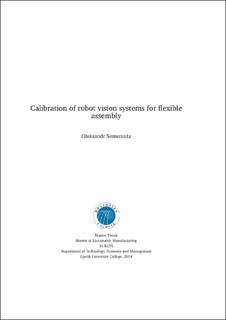| dc.description.abstract | In the contemporary competitive and fast-changing economy, the manufacturing enterprises require high degree of flexibility, to timely respond to the changing demands, and automation, to cope with the requirements of speed and quality. Industrial robots play a vital role in flexible assembly systems, and the application of machine vision in conjunction with the robotized systems constitutes a promising direction in the contemporary industrial automation. It is also of a big interest to understand the role of software in provision of assembly flexibility. In the area of robot vision systems calibration, more accurate, precise and repeatable calibration procedure are required.
This master thesis applies systems approach and is divided into two main themes, namely Software-defined assembly flexibility and Robot vision systems calibration. The first theme is aimed at understanding the concept of assembly flexibility and the role of software in its provision. This topic is considered on a high magnifying level, and is investigated by the means of literature study, systems models building and discussion. It is concluded that the there is a lack of common understanding and agreed-upon taxonomy on flexibility in manufacturing. Certain flexibility types are identified as having the biggest reliance on software. The notion of softwaredefined assembly flexibility is proposed. Machine vision and holonic manufacturing control are identified as the main enabling technologies of software-defined assembly flexibility.
The second theme is focused on robot vision systems calibration. It is viewed on a low magnifying level, and constitutes a practical undertaking aimed at studying the processes of camera calibration, stereo vision systems calibration and hand eye calibration, and improving the quality of the processes by maximizing their accuracy, precision and repeatability. A Python library FlexVi is developed and used for studying the calibration processes from the perspective of interactive computing and data analysis. The outcomes of camera calibration are analyzed on the basis of a large number of calibration experiments with the subsequent distribution fitting to find the most frequent values. A method for stereo vision systems calibration aimed at achieving high repeatability is developed. A method for outliers elimination for hand-eye calibration process is developed based on the analysis of the resulting precision of the object-to-base transformations measurement. | en_US |
